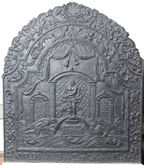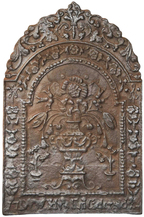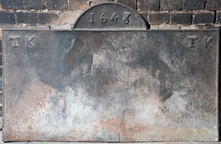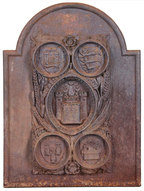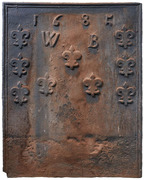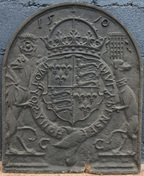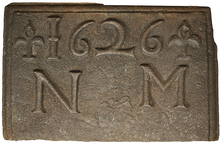-
271
Description: Arched rectangular shaped central panel with top corners cavetto canted, bead-and-pellet edging on a wide fillet; hanging drapery with central tassels over three low-arched cubicles, the two outer smaller than the centre, with Tuscan columns and overlapping scales behind; on a plinth of overlapping scales with a scallop shell behind, the standing figure of Neptune/Poseidon, holding a trident in his right hand; water issues from by his feet and from the waves below him disport two ‘sea horses’ and three dolphins; arched rectangular shaped border with top corners cavetto canted, fillet edging: suspended symmetrical beads with tassel ends decorated with sea shells; between two looped 'W' figures, the inscription separating halves of the date along the bottom; above, a central scallop shell with symmetrical floral scrolls on each side.
Notes: From a design in 'Nouveaux livres de ...Statues [etc.]' (La Haye & Amsterdam 1702-5), by Daniel Marot. The inscription, translated as 'GOD is our strength', is a paraphrase of Psalm 46: 1; the original wooden pattern is in Museum Rotterdam (no. 931}; an identical inscription and date is found on several firebacks. All incorporate the looped 'W' motif which may be intended to identify the pattern maker. Formerly at Dogwells Farmhouse, Corscombe, Dorset; other examples are at Leith Hill Place, Surrey, and Lower Brockhampton farmhouse, Herefordshire, the latter having originally been in Dunster Castle, Somerset.
Copies of this fireback are known.
Inscription: 17 DVW Ydyw Ein Cadernid 24
- Decoration tags:
- 'Dutch' (shape)
- fillet (edging)
- whole carved pattern
- pictorial
- mythological
- architectural
- text
- animals
- humans
- objects
Manufactured: in 1724 in England.
Current location: Dorset County Museum, Dorchester, Dorset, England.
(part of the Dorset County Museum museum group)
- Attached to series:
- 1724 series
- Welsh inscription series
- British 'Dutch' style firebacks
-
227
Description: Arched rectangular shaped central panel with bead edging on a wide fillet; two-handled vase with assorted flowers on a stand with scrolled legs; a plant pot on each side; arched rectangular shaped border with fillet edging, symmetrical floral fronds descending from a rose, top centre, with a looped 'W' in each shoulder; inscription at base; on top, symmetrical scrolled plant tendrils.
Notes: One of the two largest of six flower vase designs in this series. All incorporate the looped 'W' motif which may be intended to identify the pattern maker. The inscription, known from other firebacks in the series, translates as 'God is our strength'. Dore & Rees Auctions, Frome, 6 Dec 2024, lot 93 (£130).
Copies of this fireback are known.
Inscription: 17 DVW Ydyw Ein Cadernid 24
Manufactured: in 1724 in England.
Current location: not known.
- Attached to series:
- 1724 series
- Welsh inscription series
- British 'Dutch' style firebacks
-
273
Description: Rectangular with twisted rope edging top and sides; central arch with twisted rope edging; date in arch (8 with flattened top); initials repeated in top corners.
Notes: An unusually large plate to have such simple decoration.
Inscription: 1648 / TK TK
- Decoration tags:
- rectangular with round arch (shape)
- rope (edging)
- individual letters
- individual numbers
- text
Manufactured: in 1648 in England.
Current location: in private hands, Dorton, Buckinghamshire, England.
- Attached to series:
- Date & initials firebacks
-
1134
Description: Arched rectangular shape; astragal edging; central, vertically orientated, rectangular design comprising four circular copmpartments each containing a shield, surrounding an oval central compartment containing a castle surmounted by a crest of a hand between leafy branches all emerging from a mural crown, above is a crescent mark of cadency; the compartments are set within ears of corn with a flower head top and bottom centre.
Notes: The central design is a cast of the pattern for two panels, one on each of the pedestals of the outward-facing main columns on the Norwich Gates at Sandringham House, Norfolk. The shields are of Norfolk towns: (top left) Norwich, (top right) Great Yarmouth, (bottom left) King's Lynn, and (bottom right) Thetford. The central arms are those used by the county of Norfolk (before its official grant of arms in 1904) with the crest of the then Sheriff, Robert John Harvey of Crown Point Norwich. The gates were designed by Thomas Jeckyll and made by Messrs Barnard, Bishop and Barnard of Norwich for the International Exhibition at South Kensington in 1862. With some modifications, including the addition of the panel on the fireback, the gates were given by the people of Norfolk to the Prince and Princess of Wales (later King Edward VII and Queen Alexandra) as a wedding gift in 1863. The design on the fireback was impressed into the mould from a panel originally used in the casting of the gates. Lot 183, Dreweatts sale, Newbury, 5 June 2019.
Arms: City of Norwich, Borough of Great Yarmouth, Borough of King's Lynn, Borough of Thetford, County of Norfolk
- Decoration tags:
- rectangular with round arch (shape)
- astragal (edging)
- carved pattern panels
- heraldic
- armorial
- plants
Manufactured: in the mid- to late-19th century probably at Norfolk Ironworks, Norwich, in the Norfolk area of England.
Current location: not known.
- Attached to series:
- Miscellaneous stamp firebacks
- Commemorative firebacks
-
291
Description: Rectangular; astragal with cavetto-moulded edging (top and sides); date top centre; initials evenly-spaced below date; low-relief fleur de lys stamp repeated three times down each side, and in triangular arrangement below initials.
Notes: The initials may relate to William Boevey who was owner of Flaxley furnace from 1683-92. Another fireback with the same date and initials, and fewer fleurs, is also known. Formerly at Flaxley Abbey, Gloucestershire. Dreweatts Auctioneers, Newbury, 3 Oct 2022, lot 183 (£240).
Inscription: 1685 / W B
- Decoration tags:
- rectangular (shape)
- astragal with cavetto (edging)
- carved stamps
- heraldic
- text
Manufactured: in 1685 at Flaxley Furnace in the Forest of Dean area of England.
Current location: not known.
Citation: Bick, D. E. [incorrectly printed as Bick, R.], Sept 1985, 'Firebacks', Period Homes, pp. 21-4.
- Attached to series:
- Boevey series
- Date & initials firebacks
-
1261
Description: Arch-shaped; fillet edge; at top, date split by crown (horizontal of '7' missing), crown over a Tudor shield, garter (motto clockwise but reversed) and supporters; rose with viscount's coronet on dexter, and portcullis (grid of 16) with viscount's coronet on sinister side of crown; the supporters, a dragon and a greyhound, stand on separate plinths; the initials, G C, are placed in either side of the garter buckle.
Notes: There are several firebacks with the Tudor royal arms that were probably originally produced in the Spanish Netherlands, perhaps illustrating the association between England and Spain through the marriage of Henry VIII and Katherine of Aragon. The firebacks differ in several small details, such as the shape of the shield, the form and rotation of the Garter motto, the style of the crown, the positioning of the supporters in relation to the Garter, and the form and size of the crowned rose and portcullis. Hôtel Drouot auction, Paris, 21 Jan 2023, lot 89.
Inscription: 15 70 / HONY SOYT QVI MAL Y PENSE / G C
Arms: Tudor royal
- Decoration tags:
- rounded arched (shape)
- fillet (edging)
- carved stamps
- whole carved pattern
- heraldic
- armorial
- royal
- text
- animals
Manufactured: in 1570 possibly in the Wallonia area of Luxemburg.
Current location: not known.
- Attached to series:
- Tudor royal armorial firebacks
- Continental Tudor royal armorial firebacks
-
869
Description: Low arched central panel with fillet edging; on a square frame in perspective, a small gadrooned pot with flowers, including daffodils and tulips, issuing from it; narrow fillet border of same shape, around top and sides, containing a repeated chain and tassel design; wide outer border with quasi-symmetrical, wave-shaped top, swirled floral design of hare bells and tendrils; inscription at bottom.
Notes: In the museum guide of 1912, this fireback was said to have come out of an old house at Arran Quay, Dublin.
Inscription: IP 1737
Manufactured: in 1737 in Ireland.
Current location: National Museum of Ireland, Benurb Street, Dublin, Dublin, Ireland.
Museum number: NMIDM:1910.564 (part of the National Museum of Ireland museum group)
- Attached to series:
- British 'Dutch' style firebacks
-
1177
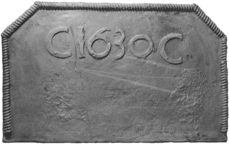 ? x ? mmImage subject to copyright
? x ? mmImage subject to copyrightDescription: Canted rectangular shape; twisted rope edging (top and sides); top centre, inscription 'C1630C'.
Notes: In the inscription, the letter 'C' may have been formed from a horseshoe. The fireback was discovered in 1959 at the works of Samuel Lewis & Co. Ltd. at Netherton, Worcestershire. It has been suggested that it was probably made by Walter Chetwynd, tenant of the ironworks at Cannockwood in Staffordshire who is mentioned as such in accounts of 1636 and 1637 made by Roger Jones received for William, Lord Paget of Beaudesert, the owner of the works.
Inscription: C1630C
- Decoration tags:
- rectangular with canted top corners (shape)
- rope (edging)
- simple stamps
- carved stamps
Manufactured: in 1630 possibly in the Cannock Chase area of England.
Current location: not known.
- Attached to series:
- Date & initials firebacks
-
1107
Description: Rectangular shape; ovolo edging (top and sides); top centre, date between two fleurs-de-lys; below, initials spaced apart.
Notes: A small fireback, probably for an upstairs fireplace. Formerly at Cothay Manor, Wellington, Somerset. Auction: Duke's, Dorchester, 7 Sep 2018 lot 585 (£360).
Inscription: 1626 / N M
- Decoration tags:
- rectangular (shape)
- ovolo (edging)
- individual letters
- individual numbers
- heraldic
- text
Manufactured: in 1626 in England.
Current location: in private hands, Wigmore, Herefordshire, England.
- Attached to series:
- Date & initials firebacks
-
1312
Description: Arched rectangular shape with small rhomboidal flanges in the corners of the arch, the top of the arch comprising two opposing loops; cavetto moulded edging; crowned circular shield within a Garter of the Stuart royal arms of England with crowned lion and unicorn supporters.
Notes: One of several variations of the arms of the Stuart royal dynasty on firebacks. Duke's auctioneers, Dorchester, Dorset, 10 Jun 2025, lot 9.
Copies of this fireback are known.
Inscription: [Garter and royal mottoes illegible]
Arms: English Stuart royal
- Decoration tags:
- rectangular with round arch (shape)
- cavetto (edging)
- whole carved pattern
- heraldic
- armorial
- royal
Manufactured: in the mid- to late-17th century in England.
Current location: not known.
- Attached to series:
- Stuart royal armorial firebacks
